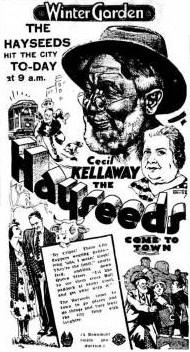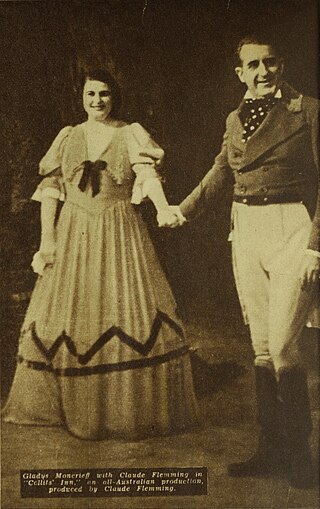1934 radio adaptation

The musical was performed on Australian radio on 29 December 1934. [8]
| The Cedar Tree | |
|---|---|
| Music | Varney Monk |
| Lyrics | Varney Monk Helene Barclay |
| Book | Edmund Barclay |
| Productions | 1934 Princess Theatre Melbourne [1] 1935 Criterion Theatre Sydney [2] |
The Cedar Tree is an Australian musical play produced in the wake of the success of Collits' Inn . The 1934 Melbourne production at the Princess Theatre was presented by F. W. Thring and starred Gladys Moncrieff.
It was inspired by a visit Varney Monk made to the town of Windsor in New South Wales. [3] [4]
Edmund Barclay had written a number of radio revues for the ABC and he was enlisted to write a musical. He said:
The story is not historical, but original, and worked out against a historical background. The ‘Australian atmosphere’ is not thrust at the audience in large chunks, and there are no kangaroos hopping across the stage, and, unless the producer decides otherwise, there will not be one single solitary pair of whiskers. The comedy part is of ‘The Flying Pieman,’ a well- known identity of the Hawkesbury Road, who caused a great deal of comment. He used to think nothing of carrying a live goat on his shoulders from Parramatta to Windsor for a trifling wager. We have endeavored to make the comedy an integral part of the plot, and not just put in as an afterthought. [5]
The part of the Pieman was devised for George Wallace who had been in Collitts Inn. However Wallace was busy making films so Alfred Firth played it instead. [5]
Reviews were positive [6] however it failed to repeat the success of Collits Inn.
Everyones said it "abounds in delightful melodies for which Mrs Varney Monk can take a bow. Gladys Moncrieff renders her numbers in excellent voice, her duet with Russell Scott, “It Had To Be,” earned great applause, while all the songs registered' with the audience... “The Cedar Tree” from start to finish is excellent entertainment, the whole cast has worked hard to make it a success, and F. W. Thring deserves all possible in this respect." [7]

The musical was performed on Australian radio on 29 December 1934. [8]
A story of cedar cutters and boat builders on the Hawkesbury River in the 1840s. [9] It involves two acts and eight scenes with a gap of two years between the acts. [10]
A woman carries on her deceased father's business of building ships built from cedar trees. Her spoilt younger brother bails up one of his sister's lovers on the highway to get money to pay debts. The lover tries to save him from prison and returns the money while disguised as a notorious bushranger. However the Flying Pieman arrives, thinks he's a real bushranger and tackles him. The lover leaves town to avoid being arrested. The younger brother writes a confession and hides it in the hole of an old cedar tree. It is discovered tow

Gladys Lillian Moncrieff was an Australian singer who was so successful in musical theatre and recordings that she became known as 'Australia's Queen of Song' and 'Our Glad'.
Efftee Studios was an early Australian film and theatre production studio, established by F.W. Thring in 1930. It existed until Thring's death in 1935. Initially Efftee Films was based in Melbourne and used optical sound equipment imported from the US.
Harmony Row is a 1933 Australian musical comedy directed by F. W. Thring and starring popular stage comedian George Wallace. It marked the film debut of Bill Kerr.
A Ticket in Tatts is a 1934 musical comedy film starring popular stage comedian George Wallace as an accident-prone stablehand. It was the last of three films Wallace made for F. W. Thring.

The Hayseeds is a 1933 Australian musical comedy from Beaumont Smith. It centres on the rural family, the Hayseeds, about whom Smith had previously made six silent films, starting with Our Friends, the Hayseeds (1917). He retired from directing in 1925 but decided to revive the series in the wake of the box office success of On Our Selection (1932). It was the first starring role in a movie for stage actor Cecil Kellaway.
Edmund Piers Barclay was an English-Australian writer known for his work in radio drama. Radio historian Richard Lane called him "Australian radio's first great writer and, many would say, Australian radio's greatest playwright ever." Frank Clelow, director of ABC Drama, called him "one of the outstanding radio dramatists of the world, with a remarkable technical skill and ability to use the fade-back without confusing the audience."
Joseph George McParlane, known as Joe Valli, was a Scottish-Australian actor who worked in vaudeville and films. He had a long-running vaudeville partnership with Pat Hanna as "Chic and Joe".
Campbell Copelin was an English actor, who moved to Australia in the 1920s and worked extensively in film, theatre, radio and television. He had a notable association with J.C. Williamson Ltd and frequently collaborated with F. W. Thring and Frank Harvey. He often played villains.

Collits' Inn is an Australian musical play with music by Varney Monk. Its first staging was in December 1932 at the Savoy Theatre in Sydney. The 1933 Melbourne production at the Princess Theatre was the first fully professional production, presented by F. W. Thring and starring Gladys Moncrieff, George Wallace, Claude Flemming and Campbell Copelin. Wallace's role was created especially for him. It is generally considered the first commercially successful Australian musical, and it was praised by the Sydney Morning Herald as "an Australian opera".
Sheepmates was a proposed Australian film from director F. W. Thring based on a 1931 novel by William Hatfield. It commenced filming in 1933 but was abandoned.
The Man They Could Not Hang is a 1934 Australian film directed by Raymond Longford about the life of John Babbacombe Lee, whose story had been filmed previously in 1912 and 1921. These silent films were called "one of the greatest box-office features that ever came out of this country." The sound film was not as successful.

Varney Monk was an Australian pianist and composer, best known for writing the musicals Collits' Inn (1932) and The Cedar Tree (1934). Collits' Inn was described by the Sydney Morning Herald as "an Australian opera".

The Haunted Barn is a short 1931 Australian comedy film produced by F.W. Thring directed by Gregan McMahon. It was one of the first productions by Thring's Efftee Studios. The film was produced to support of the feature Diggers (1931) and shown on the same bill.
Ned Kelly is a 1942 radio play by Douglas Stewart about the outlaw Ned Kelly.
For the Term of His Natural Life is a 1935 Australian radio serial based on the novel of the same name by Marcus Clarke.
Henry Lawson Stories was a name given to a series of 1937 Australian radio plays on the ABC where Edmund Barclay adapted stories of Henry Lawson.
Captain Swift is a 1888 stage play by Australian author C. Haddon Chambers. It was turned into a 1920 film Captain Swift and adapted for radio. The play was one of the first plays by an Australian with Australian characters to achieve success overseas.

Love o' Land is a 1934 Australian radio play by Edmund Barclay. It was described as a "cavalcade of Australian history" and involved a family whose adventures coincided with ten scenes in Australian history from 1788 onwards.
Avalanche is a 1934 Australian radio drama by Max Afford. It was a significant work in Afford's early career.
Oh! What a Night! is a 1932 Australian short film written by and starring George Wallace.